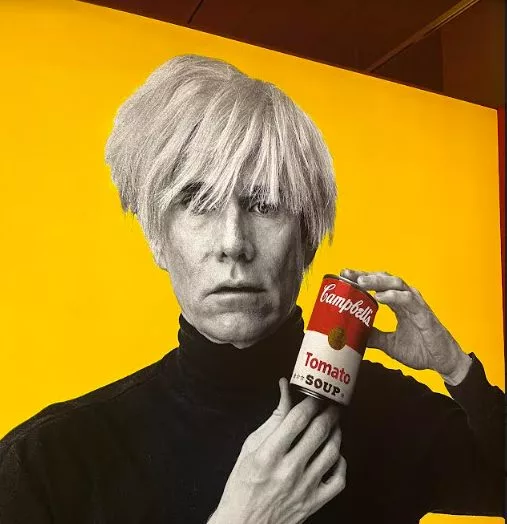At the meeting point of the Austrian, Swiss, and German borders lies the historic old German town of Lindau. The entirety of the old town is separated from the ‘mainland’, a tiny island of about 70 hectares on Lake Constance (or ‘Bodensee’ in German). Though this part of the city is only home to about 2800 people, the historic island attracts many visitors. Restaurants line the lake-side promenade and the town offers incomparably stunning architecture; a giant stone lion opposite a lighthouse, and plenty of historic towers and churches. Most shops are small business operated.
If you were to visit the island now, there is one man you wouldn’t be able to escape: Andy Warhol. His face in black and white on yellow background adorns posters in nearly every shop window and one of the local bookshops has a whole display of different biographies and prints centering the artist. When you enter the island by crossing the bridge you are greeted by large banners sporting the artist’s name. 100 pieces by Andy Warhol are being displayed here until late October, all thanks to a small art museum close to the island’s train station.
For the unacquainted, an exhibition of this scale at the simply named ‘Kunstmuseum Lindau’ (Art-Museum Lindau) may be quite surprising; a town of that size becoming a temporary home to world-famous and priceless pieces of art? In fact, showcasing big names such as Andy Warhol has been common practice since 2011. In 2013, the museum was first able to show select pieces by Picasso. In the summer of 2021, an exhibition of the works of Mark Shargal attracted around 50.000 visitors, so the expectations for this year’s exhibition to measure up are quite high.
How does a Warhol exhibition of this magnitude come to be for such a small museum? A member of staff was able to give some insider knowledge. It all started with last year’s exhibit which showed a wide-ranging collection of works on the theme of nature by such artists as Monet, Renoir, Picasso, Gauguin, and two pieces by Warhol. Establishing private collection connections was instrumental. Indeed, most of the exhibitions at the museum are put together in collaboration with private collectors. In this case, however, a connection to the Andy Warhol Foundation had to be made as well. The most expensive affair in this case, according to the member of staff, was the insurance.
I was able to visit the exhibition twice, once with and once without an audio guide. The tour using a guide lasts about 38 minutes, giving insight on select pieces including context and background of the artworks, Warhol’s life, and a few explorations of pop art as a movement. Screens around the space offer additional information in both English and German accompanied by videos of Warhol.
Though personally, I’m usually not the biggest fan of audio guides, I think in this instance they are very much necessary. Otherwise, the walkthrough might be over quite quickly (there is only so much time you can spend on just staring at ten prints of Marilyn Monroe). Because Warhol’s art is heavily based on and inspired by pop culture it benefits from some background information.

Most of the pieces shown are Warhols originals produced in the ‘Factory’ using his silk-screen printing technique. Subjects include: Liz Taylor, Marilyn Monroe, Grace Kelly, Queen Elizabeth II, and Mick Jagger. What interested me much more than his icon-status prints, however, were two series of much lesser-known pieces. The first is a series of coloured illustrations on paper, titled ‘25 Cats Named Sam’. These illustrations came to be when Warhol was working as a children’s illustrator and was living with his mother with (you guessed it!) twenty-five cats all named Sam. The paintings are vibrant and childlike and give off a certain authenticity, though not in the style we associate with the artist today.
An even more unavowed series of sketches is displayed just on the opposite wall. They are part of a sketchbook from 1955 titled ‘House of Hearts’. The pieces are currently privately owned and prints and photographs of them are incredibly hard to find, even on the internet. This fact might have intrigued me the most, along with the intimate nature of the sketches. The main subject is a man with wavy hair dressed in an elegant suit. The series shows him in different positions, tenderly blowing kisses or fanning himself with a large feathery fan. Warhol’s art has reached such notoriety and icon status that lesser-known works and collections such as the two described above seem much more intriguing than Marilyn Monroe or the Campbell’s soup cans.
The guided tour ends on a sombre note, briefly describing Warhol’s personal struggles with his shyness and identity. Although I was largely satisfied with the narration and context given, I was missing some exploration of the art scene which Warhol inspired and fostered (Basquiat, Haring, the Velvet Underground, etc). Nonetheless, I find this exhibition well put together and accessible, and would recommend even if you’re not a diehard pop-art fan.
The museum is worth keeping an eye out for future projects of this scale – I am sure there are many more to come. As a former local, I would naturally recommend a visit to the island if you ever find yourself in around – Lindau has so much to offer.


